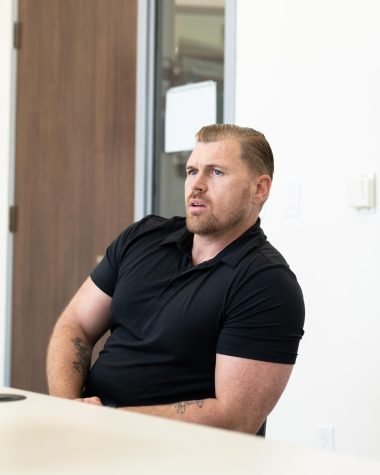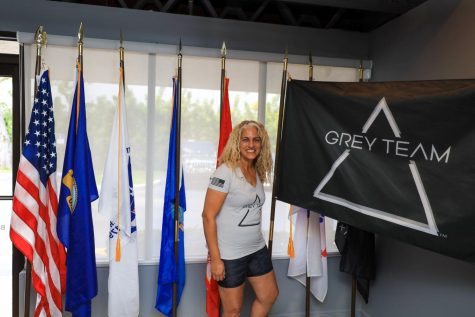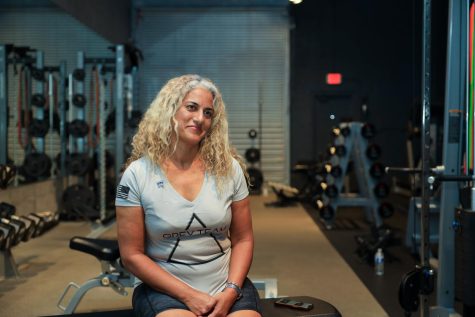‘I’ve buried myself five times’: Struggles of mental health within the military
The military often stigmatizes mental health and its members are left unsupported and struggling.
April 26, 2023
“You took me with you. I’ve buried myself five times and I’m tired.”
Last month, Bryan Drake faced a harsh reality familiar to many of those who have served in the military – one of his friends and colleagues from his time in the service committed suicide. This was the fifth time the 4-year Marine Corps veteran received this agonizing call.
“It’s always the ones that you never see coming,” he detailed tearfully.
The suicide rate for Veterans is 150% higher than that of the general population, according to a 2023 article released by the American Addiction Centers.
Drake views the discrepancy as a symptom of a larger issue; a lack of mental health education and resources in the military.
The Conversation
A 2022 study conducted by the U.S. Department of Veteran Affairs (VA), reported that 6,146 veterans committed suicide in 2020, equating to 16.8 suicides per day. Veterans who retired in 2019 were at the highest risk of suicide compared to years past.
Drake claims the military exploits individuals in vulnerable situations, which he believes could contribute to the high suicide rates.
“The military is really good at two things: preying on the weak and the poor and people who feel like they don’t have anywhere else to go,” he said.
Drake said during his service, there was little to no conversation about mental health and any conversation was in “strip clubs or bars” with other veterans.
“The majority of them are already broken, and the military does not help.” he said.

Michael Carroll, a 10-year Marine Corps veteran, disagreed. He said there was a conversation surrounding mental health, but it was one of silence and shame.
“There was a culture of mental health, it was called, ‘Take a big pill, suck it up and go and move on with your life.’”
Carroll and many of his colleagues abused alcohol as a coping mechanism, Drake included.
“Everyone knows what’s going on. Everyone’s depressed. Everyone’s a functioning alcoholic,” Drake said.
Both Drake and Carroll explained, once a service member brings their mental health issues forward they are removed from their position which can come with an air of disappointment and shame, exacerbating pre-existing mental health issues. This experience pushes them away from using the resources that are available to them.
Lisa Browne Banic, a 20-year active-duty Army and Reserve veteran, said she experienced a similar culture.
“If you didn’t have your shit together, you were wrong,” she said.
Banic said the only conversation around mental health issues took place when she retired. She now serves as a mentor at Grey Team, a Boca Raton based non-profit and veteran owned health and wellness organization whose mission is to reduce veteran and post-traumatic stress disorder (PTSD)-related suicides.
Gender Issues
According to the Department of Justice Annual Report on Sexual Assault in the Military, 35,875 service members experienced some form of unwanted sexual contact in 2021, which includes roughly 8.4% of active-duty women and 1.5% of men.
Banic believes this number is inaccurate due to victims not reporting their experiences.
“Statistics say that 4 out of 5 females and 1 out of 6 males experience military sexual trauma. I would bet money that it’s more; I believe it’s 5 out of 5 females,” she said.
Banic continues, there is little support for anyone who experiences sexual trauma in the military and that often holds devastating effects for victims.

She also argues the lack of reporting and conversations about military sexual trauma furthers a negative narrative and stigma for victims.
16% of women and 1% of men reported gender discrimination in 2021 and 29% of women and 7% of men reported sexual harassment – two statistics that overlapped for Banic when she was told why she did not qualify for promotion during her time in the service.
“I actually believe that I didn’t get promoted to a higher rank because I would not be in sexual relations with some of my decision makers,” she said.
Carroll believes situations like this have a significant toll on women’s mental health while serving. He said oftentimes women hide their experiences because they don’t want to be “slut-shamed.” Banic agreed with this, saying women also hide their stories out of fear of losing their position.
Drake believes the stigma around mental health is especially harmful to males because “masculinity is a top priority” for men in service.
Women have an entirely different culture around mental health than men, Banic argued. She outlined the intensified pressures and stigma on women, attributing it to many issues, including the military being a male-dominated profession.
Banic gave birth to her daughter while in the Reserve. At the time, federal law did not allow for maternity leave and because of her position, she had to take a leave of absence, losing all of her health benefits.
Doing so had major consequences for her overall health. While she was supported by other serving mothers, she said she often relied on food from her church to support her and her daughter. This coupled with little mental health resources led to a decline in her mental state.
“I should have been able to rely on the military and I couldn’t because of the law,” Banic said.
Since then, the federal laws have changed allowing maternity and paternity leave, as well as other resources for parents.
Transitioning
According to Carroll, leaving the military can be one of the most impactful times in a veteran’s life.
“It’s the number one hardest job you’re going to do as a military service member. The more years that you put into the service, the harder it becomes to transition,” he said.
Drake agrees, saying that differences between military and civilian culture have made it difficult to connect with non-veterans since leaving the service, so as you leave the military you lose a close community of peers and friends who understand you on a level others cannot.
“It’s really fucking lonely,” said Drake.
Carroll feels that the military neglects to support service members transitioning back to civilian life.
“My life got flipped upside down, turned around, and they threw me in the trash,” Carroll said.
Ways to Help
Drake, Banic, and Carroll believe one of the best ways to help veterans is to foster communities where discussions on the intersections between mental health and veterans are supportive and open.
Banic urges civilians to put effort toward assisting veterans before times of crisis and to practice empathy and compassion when speaking to them.
“The United States military is probably the most encompassing in terms of inclusivity and diversity and if we have all this talent, imagine if the communities opened their arms to all of what we are instead of throwing us in the broken toolbox,” she said.

Additionally, Banic encourages veterans to form communities and openly share their experiences. She believes education is the key to stopping stigma and changing the narrative surrounding veterans.
Drake hopes non-veteran civilians will understand veterans are often caring and kind people who served for the greater good.
“They will give you the shirt off your back whenever you need it. In the freezing cold, they’ll give you their coat and they will freeze to death before they let you do that,” he said. “They are great people. The majority of them are just already broken and the military does not help.”
Editor’s note: This story is in the UP’s latest issue that can be found physically on the distribution boxes around campus or digitally through our Issuu page.
Jasmine Die is the Copy-Desk Chief for the University Press. For more information regarding this or other stories, email jdie2018@fau.edu.
Savannah Peifer is the Editor-in-Chief for the University Press. For more information regarding this or other stories DM her @ginger.savvy or email her at savannahpeifer22@gmail.com.







NoTadded • Nov 25, 2023 at 4:34 am
Oh, wow, it’s so nice to see you glorify my highschool bully Bryan Drake